Denon DP-3000NE Direct-Drive Turntable with DL-103, DL-103R, and DL-A110 Cartridges
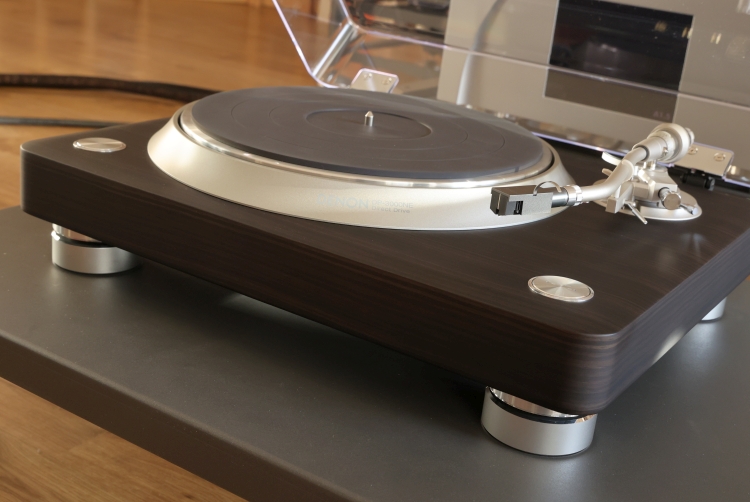
Review sample supplied by Masimo
Retail prices:
DP-3000NE – 2.499 euro
DL-A110 Headshell and Cartridge – 600 euro
DL-103 Cartridge – 329 euro
DL-103R Cartridge – 429 euro
Denon has a strong reputation for its direct-drive designs of the past, and the DP-3000NE is their current flagship premium direct-drive turntable. Featuring a carefully designed S-shaped tonearm with optimized tracking, this newly improved Denon arm is equipped with cartridge weight adjustment, anti-skating compensation (0-3 g), and a newly developed arm height adjustment ring (0-9 mm).
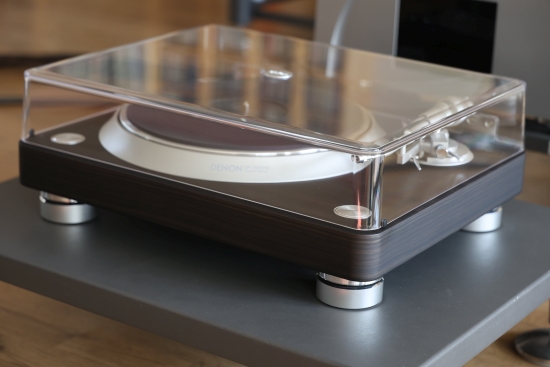
The turntable’s sturdy and surprisingly heavy construction, weighing in at 18.5 kg, combined with extra large height-adjustable damping feet, provides a very rigid and low-resonance foundation.

The DP-3000NE incorporates the new SV-PWM-controlled Quartz-Locked motor system that guarantees an extremely accurate RPM with less than 0.06 % WRMS. A soft touch button starts platter rotation, and a second soft touch button selects between 33 1/3 rpm and 45 rpm speeds.
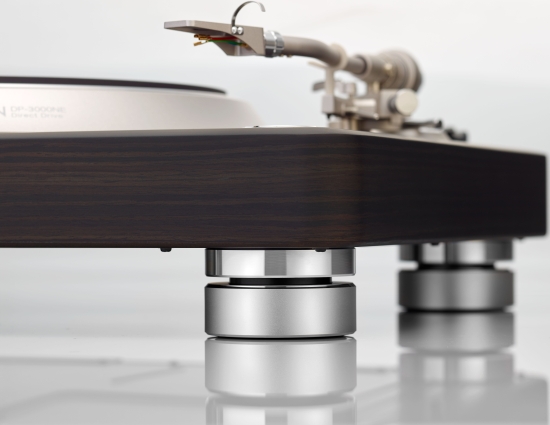
According to the Denon website, the turntable even supports 78 rpm records. At first, I thought it may have been a mistake because the speed button is labeled 33/45, but when reading the manual, I discovered that you can select 78 rpm by pressing the Speed button while also pressing the START/STOP button. After that, both speed lights turn on to indicate the selected 78 rpm speed.
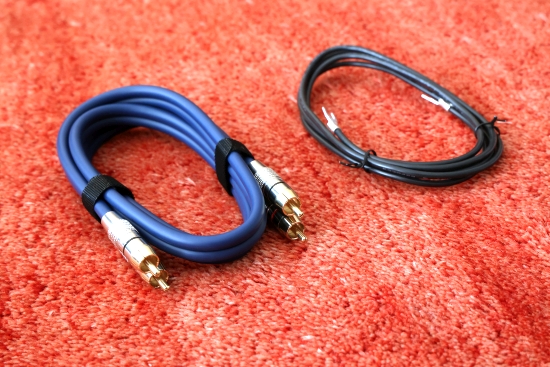
The turntable comes complete with a nice interlink and earth cable. The interlink provides a smooth and non-aggressive sound. But the turntable is well worth spending extra on interlinks. For instance, I obtained better definition, transparency, refinement, and dynamic impact with the Driade Flow Link Reference 808.
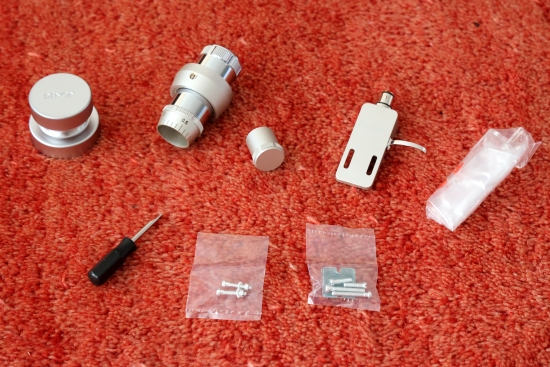
More accessories: 45 RPM adapter/record weight, counterweight with extra add-on weight, aluminum headshell, cartridge adjustment gauge, screwdriver, headshell screws, and spacers
Thanks to the strong motor, the platter is at the target speed within half a turn (under 1 second for 33 rpm), and a nice extra advantage of Direct Drive is that there is no belt to wear out and no parts to replace. I am particularly sensitive to speed variations, but the speed was always 100% stable with this turntable. Lastly, but not unimportantly, the 100% seamless dark ebony natural wood veneer adds a very classy touch, and a nice crystal-clear dust cover completes the package.
Rigid versus damped construction
While handling the DP-3000NE’s tonearm to attach the headshell, I noticed that the arm has considerable play in all directions. Even when fitted very securely, the headshell can rotate around its axis (Azimuth) by quite a large amount, and it does not have a defined mid-position. Furthermore, the arm bearing also has considerable play both front-to-aft and sideways. Upon closer inspection, I discovered that I could wobble the counterweight section up and down by rotating the headshell around its axis. That’s when my initial infatuation started to dwindle, and suspicion arose that my sample might not be optimal. Not wanting to reach the wrong conclusions, I held off on listening to the turntable and sent an email to Denon.
I’m glad I asked, as it turns out that all this is by design.
Senior Sound Engineer Rainer Finck provided the following explanation:
“There are two basic philosophies. Make everything as rigid as possible or make it loose and damp it. The Denon tonearm may look conventional, but it has a unique geometry, and it looks rigid when it’s not. The so-called Unipivot (single point bearing) tonearms have play in all directions and are usually damped by a silicon oil bath. With the Denon tonearm, the damping is defined by special materials.”
In addition to providing Rainer’s initial response, Denon relayed my concerns to Ryo Okazeri, Denon’s turntable engineer in Japan, who kindly responded:
“It is understandable that audio intellectuals like a tonearm to be rigid. However, we made particular considerations concerning the arm’s physical characteristics for the Denon tonearm. In particular, we aimed to remove the typical peaks and dips in the frequency response of the tonearm pipe that are caused by resonance and mechanical rattling”.
To illustrate that point, he provided two graphical responses. Below are the measurements of a rigid-construction tonearm, similar in design to the familiar Technics tonearm. Note the resonance peaks circled in red.
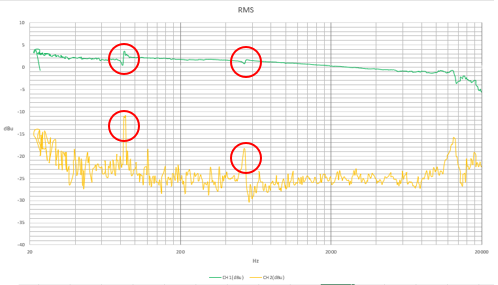
“These peaks and dips became an issue for the NHK broadcaster; thus, Denon studied this problem and came up with the loosely coupled and dampened construction as a resolution.”
Below are the measurements of the DP3000NE tonearm; note the flatter response.
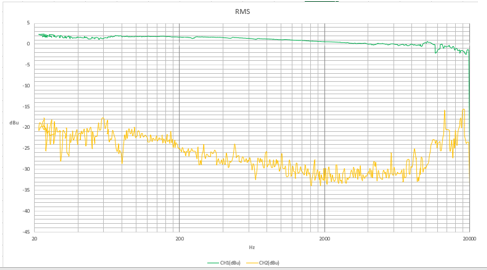
Mr. Ryo Okazeri continued to explain that the play that I noticed when handling the tonearm is a direct result of how it was designed. The tonearm pipe is not fixed to the main body. Rather, it is fixed through a plate spring and damper.
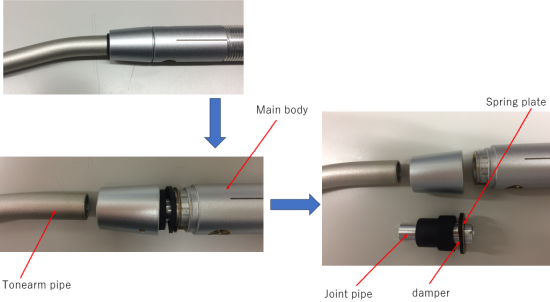
The same principle applies to the pivot bearing, which is not mounted rigidly but installed in a cushioned manner.
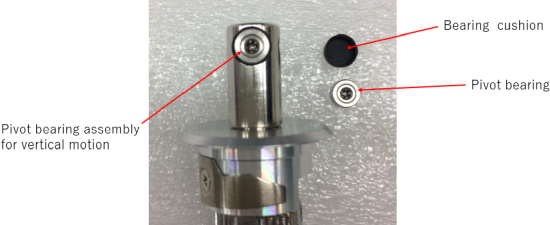
“The Denon tonearm does not appear rugged compared to other makers’ tonearms, and the concept is different from the general conceptions, but it makes a lot of sense from an engineering viewpoint.”
After reading the above feedback, it became clear that damping is a major theme in this turntable’s design, and it’s not just in the tonearm, but it is everywhere in the turntable. From the large damping feet to the damped platter and the specially constructed tonearm, and even inside the headshell, the main objective was to get rid of bad resonances.
Next: DL-A110, DL-103R, and DL-103, Cartridges
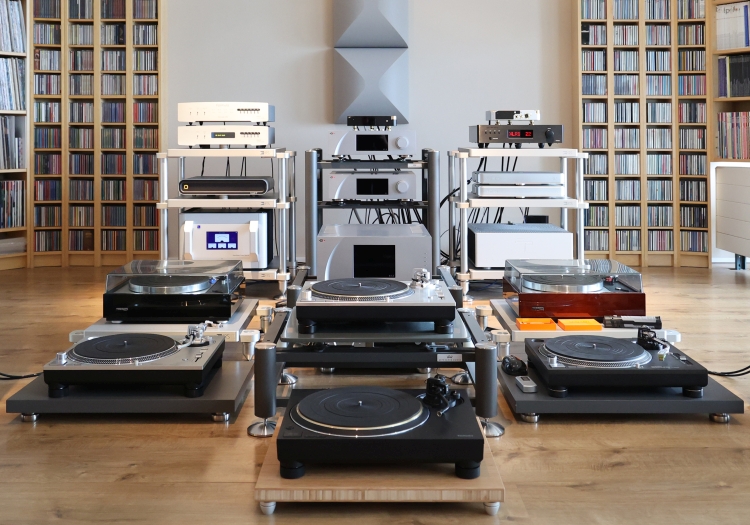
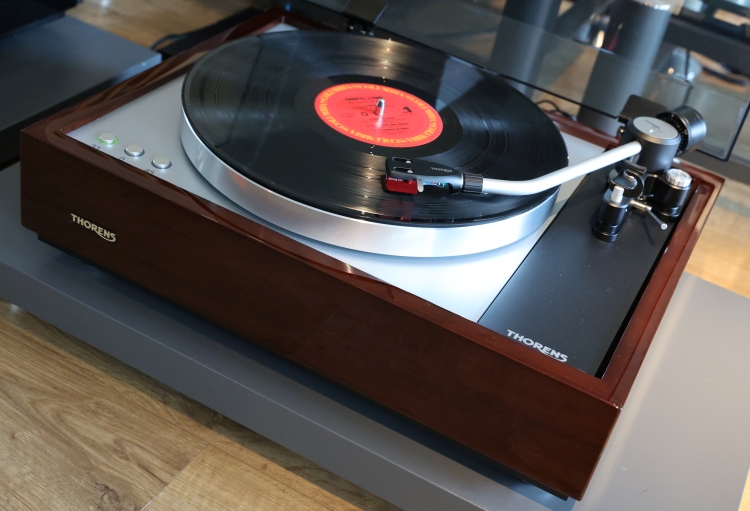
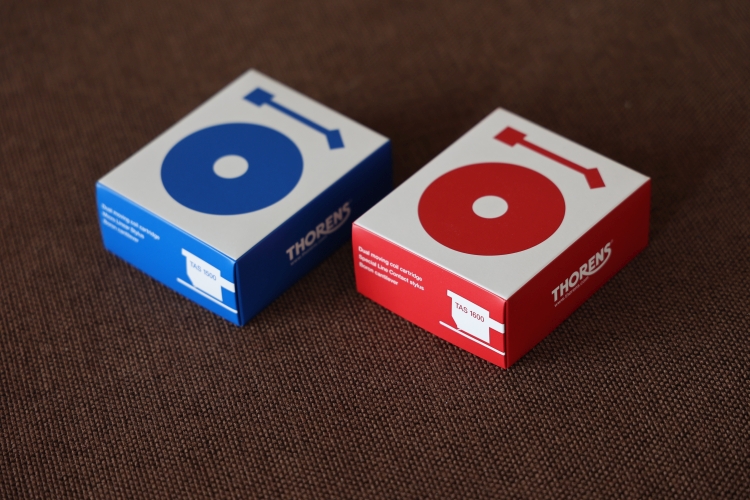
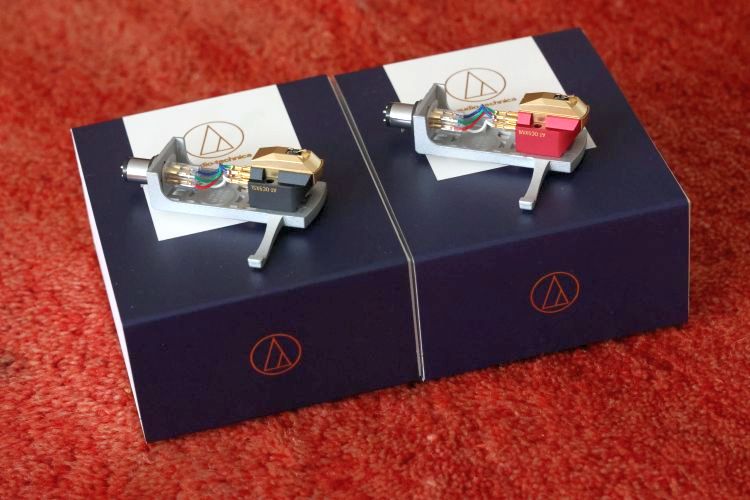
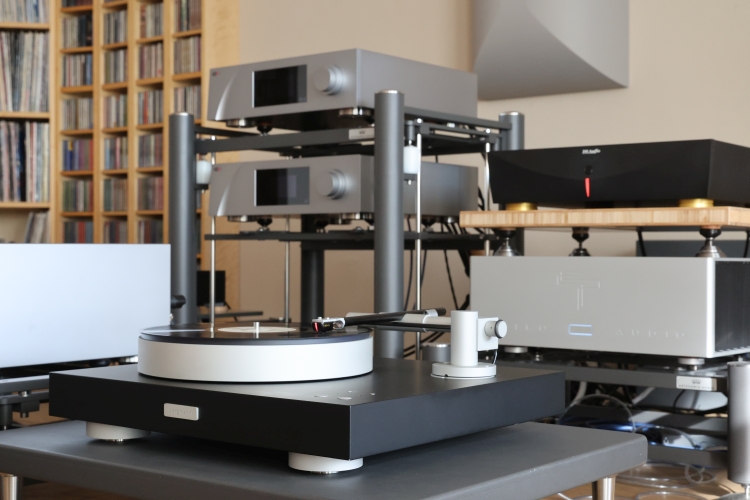
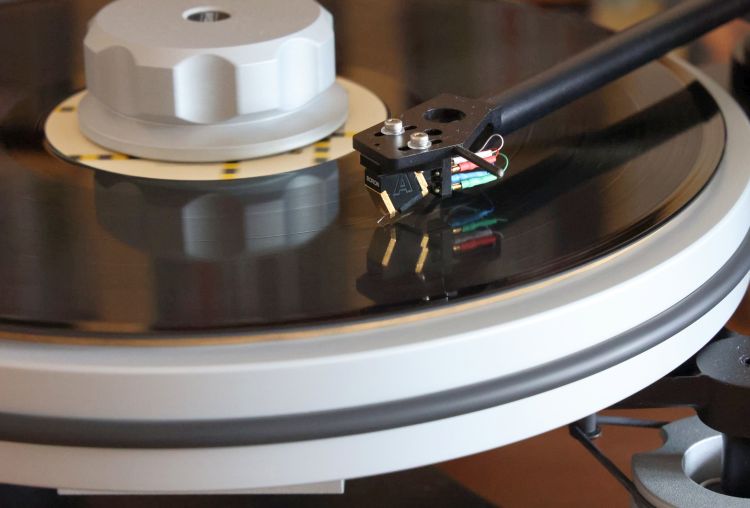
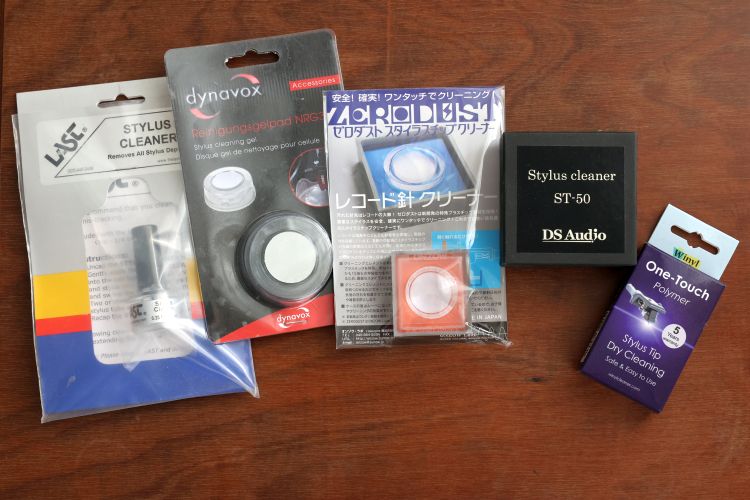
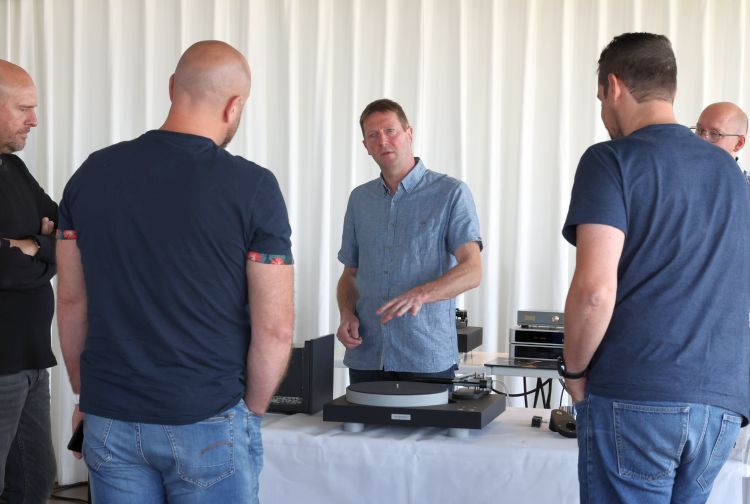
Christian another fantastic review lots of comparisons and common sense and a distinct lack of hyperbole well done. And happy holidays!
Cheers,
Jon
Thanks for the nice feedback, Jon! Happy days for you, too!
Excellent, and insightful review. I have a Denon DP- 3000NE and concur with all of your observations…with one exception….there is no Ebony Wood Veneer on this table.
The outer surface of this table is metal (probably aluminum ), with an anodized finish that has the “appearance” of Ebony.
At any rate, the Denon DP-3000NE is a superb table and allows one to enjoy their music at a very high level
Cheers.
Thanks for the info, Thomas! I wondered how they got it to be this utterly seamless! So now I know:-) But I can tell you from touching it and inspecting from real close, to these ageing eyes at least, it looks really nice and truthfully resembles real wood.
Re: the ebony that is not the reviewer’s observation but official specification from Denon. I have felt underneath mine and there is a rough wood feeling where the surround is unfinished unlike the top and sides where it is incredibly smooth. I would say that I wouldn’t bet my life on it though as it is so smooth and cool to the touch. I just don’t understand how they could claim ‘dark ebony natural wood veneer’ if it isn’t.
Your Turntables are awesome!!
Hi Christian, thank you for the review. If you have to chose between Denon dp 3000ne and Thorens td1500, what would you do or maybe you have some thoughts about it?
I’ve not yet heard the TP-160 tonearm that’s on the TD-1500 prefer the Thorens, but based on personal taste, as well as the more precise tonearm, I prefer the TD-1601 to the DP-3000ne.
I do not agree with the views expressed about tge Technics SL-1200G. I have four turntables and acquired the Denon recently. One of my turntables is a Technics SL-1200G. The other four are a VPI Titan Direct, a Linn LP12 modified in Scotland, a Continuum Audio Labs Caliburn with Cobra tone arm, and a Bergmann Galder-Odin Signature. The Technics is fitted with a Hana Umami Red cartridge and it sounds wonderful with classical and jazz music, which comprises about 95% of the music I listen to. I found that the Technics makes a better more refined presentation than the the Denon, while the Denon has a more foward presentation. The Denon is equipped with a Denon 103R cartridge.
The Technics I used was an old SL-1200 MkII, not the latest 1200G, maybe that accounts for the difference?
Hi Jose, you have some amazing turntables there, especially the Caliburn. I was wondering how the Denon with the 103R really does compare with the others in your stable?
A 4000.00 cartridge in the Technics and a 400.00 cartridge in the Denon…..perhaps that may have had something to do with your observations between these two excellent tables.. ..
Cheers…
The SL1200 and the DP-3000NE were compared using the exact same Denon DL103 cartridge, first, with two DL-103’s in their respective headshells, then by swapping a single headshell with mounted DL-103 between the turntables. And I did that both ways, so with Technics headshell in the Denon turntable and vice versa.
Actually my comments were meant for one of your other readers replies. He mentioned using a 4K Hanna Red, on a Technics 1200G in a compare with the Denon DP 3000NE that had the 400.00 Denon 103 R….Anyway I thought his observations might have been due to the different cartridges used….perhaps he swapped head shells to keep the compare even, if he did he didn’t mention it.
I noticed in Steve Gutenberg’s YouTube video review he also used a Technics 1200G in his compare. He apparently liked both tables, but mentioned that the Denon had a more relaxed, warner presentation compared to the more lively dynamic presentation on the Technics 1200G (a substantially more expensive table BTW). He was using a 500.00 Grado on both tables for this evaluation on both tables.
Ah, I see:-)
Hi Christiaan, thank you for another excellent article! I love reading your reviews – you always seem to anticipate the questions that pop into the reader’s mind and then promptly answer them. I was interested in how the Denon would compare with a SL-1200 and even how the 103, 103R and a more modern stylus profile would compare and you answered it all – thanks! I noticed that the ‘loose’ rather than ‘rigid’ approach to coupling by Denon is not unlike something you discovered with Origin Live’s Calypso turntable. Maybe there’s a similarly ‘musical’ sound shared by both decks?
Thanks again,
Adrian
Now that you mention it, there is indeed a similarity in these two approaches!
Very good review with very good insights!
Thanks, Dick!
Great review that helps my perfectly to mad a decision in buying my first direct drive turntable. Thanks a lot Christiaan! 😀👍
I read with interest your recent review of the Denon turntable. I was particularly interested in your comments about the head shells and their differences. Could you tell me if the Anniversary head shell came with the Denon table as standard or is this another head shell you refer to please?
Hi Craig, The DP-3000NE comes as standard with the aluminum headshell that is pictured in the 3rd image from the top (4th, if you include the main image). If you scroll two more pictures down, you will see the full extent of the accessories included with the DP-3000NE turntable. The DL-A110 Anniversary headshell (with DL-103 cartridge included) is available separately.
I’m not sure about the comment that denies ebony veneer. I’m sure you can feel grain underneath where it is unfinished. Surely Denon couldn’t advertise it if it wasn’t?
I’m a few days into ownership and very impressed so far.
Great review that help my decision, I was between the sl-1200GR and the Denon, and thank to your review, Denon is the winner., actually I have in my Rega a dl-103r with a Denon-au320 SUT and an old AT-OC9, that going directly to the Denon 🙂
Thanks again Christiaan, and regards from Spain
Bom vi aqui nos comentarios que o Denon não e de Madeira Ebano,si poder por o link da fonte aqui,eu pesquisei muito sobre isso,vi algumas entrevistas de funcionarios da Denon,vi tambem alguns videos falando sobre,Proprios artesão e engenheiros da Denon fala que e Ebano a madeira,um dos motivos dela ser tão pesada e por conta de suas camadas de madeira,tem um foliado ebano..Denon e um marca muito respeitada,ate hoje ainda não vi um produto falso ou imitação feita pela Denon,vi alguns criticando a Denon porque mandou a fabricar esse Gira disco Denon na china,eu paguei pra ver si prestava,comprei uma Denon DP-3000NE ,construção Premium acabamento de qualidade,não tenho o que reclamar..ate porque grandes marcas audiofilo tem seus produtos fabricado na china,Technics mudou a fabrica pra Malasya,então vejo que o que manda e a supervisão e peças que e colocado no produto,A Denon teve muito cuidado com seus engenheiros pra fazer um produto de qualidade,mesmo sendo feito na china…agora tem por ai uns falando pela internet que não e ebano mais não tem como comprovar o que fala..eu estou acreditando na Denon que ate aqui ainda não vi fazer produto falso…
It’s best if all comments are posten in English so everyone can read… translation below.
Well, I saw here in the comments that Denon is not made of Ebony Wood, if you can put the source link here, I researched a lot about it, I saw some interviews with Denon employees, I also saw some videos talking about, Denon’s own craftsmen and engineers It says that the wood is ebony, one of the reasons it is so heavy and because of its layers of wood, it has an ebony veneer. I saw some people criticizing Denon because they ordered this Denon turntable to be manufactured in China, I paid to see if it was any good, I bought a Denon DP-3000NE, premium construction, quality finish, I have nothing to complain about…even because big audiophile brands have their products made in China, Technics moved the factory to Malaysia, so I see that what is required is the supervision and parts that are put into the product, Denon took great care with its engineers to make a quality product, even though it is made in China. ..now there are some people out there saying on the internet that it’s not ebony but there’s no way to prove what they’re saying…I’m believing in Denon, which I’ve yet to see a fake product made…
Officially, it’s Ebony veneer. Traditionally, veneer is a thin wood layer but I don’t know if there are more advanced forms of veneer. What matters is that the finish looks stunning! Even up close and looking very carefully, I absolutely cannot see any evidence of it being a print. But even if it was, the quality is so high that I would argue it still would not matter.
The surface is Definitely Not A Wood based Veneer of any kind …it is clearly ( to me anyway), metal….just tap it with your finger tip and one can clearly hear the slightly “metalic” timbre that eminates….
The structure below is using some non metallic parts….probably MDF, or HDF…hence the substantial weight ( 40+ pounds).
I should mention that the lack of a real wood based Veneer finish on top in no way detracts from the overall performance of this well designed and executed table. I like it very much and at its selling price it’s an excellent value for money spent.
Please suggest an MC phono preamp that matches well with the denon DP-3000NE
That will depend on your budget and personal preferences. But for my preferences, the best, as well as best value phono preamp at 800 euros would be the Manunta EVO Phono 3. See also my review on this site. Sure, you can go (much) cheaper, but the SQ will also be MUCH lower. If you want the cheapest still ok preamp, the Schiit Mani is an option. Lastly, I’ve not heard it, but you may want to look at the 400-euro Rega Fono. But if you can spare 800 euros, I would absolutely go for the Manunta.
Thank you very much
Hi Christian, very detailed review and thanks for sharing your experience. Can you recommend an MC Phono preamp that pairs well with the DP-3000NE? My current preamplifier, the Marantz SC-7S2, does not have a phono input
Christian,
Very thorough article. I really enjoyed reading it!
I do believe that Denon is full of it, though by stating that the tonearm looseness is designed in. I bought one of these myself on Amazon. It sits right next to my VPI Prime 21.
My particular DP-3000ne does not exhibit the tonearm looseness or bearing play at all. I do believe that Denon designed the tonearm to be decoupled by using the elastic material where the different parts of the arm join together, but the loose bearings are the typical “Hanpin” slop quality.
As I stated, my Denon DP-3000ne exhibits no looseness anywhere in the arm assembly, especially at the bearings. I’m sure, being built by Hanpin for Denon, that the quality varies from unit to unit.
One thing that I have observed with my unit, is that motor stability is also typical Hanpin quality. When I first start platter rotation, the speed hunts for stability, which can take up to 8 platter rotations to stabilize.
The only measuring equipment I have is a very accurate phone app called appropriately, Turntable Speed.
Using the app, I can see when the platter is first started rotating by pressing the start button, speed goes up to 33.4x, then down to 33.2x. It ping pongs back and forth until 33.3x is achieved. The wow is anywhere from 0.01% to 0.09%.
Using the same app on numerous Technics Direct Drive turntables, the app demonstrates excellent speed stability, just about instantly achieving 33.33 with a wow of 0.01 to 0.02% respectively.
The Denon is a great looking turntable, but it still mirrors Hanpin build quality.
Hi Chris, interesting to hear your arm has no play. Maybe it’s exemplaric? In any case, for what it’s worth, my sample had stable speed. I am very sensitive to speed variations but did not detect any. I also use a phone app to measure, called RPM. It confirmed that the speed was indeed stable at 33.3 with no hunting.
Hi Christian,
After using the Denon DP-3000ne for a few weeks now, I really feel that the platter is too heavy for what the motor can handle.
I think Hanpin used the very same motor that one could ger in an Audio Technica AT-LP1240 turntable.
My speed stability has improved somewhat, over time. I now see no worse than a wow reading of 0.05% or less, which is below the Denon rating of 0.06%. By no means do I get repeatable numbers from test to test like I do with numerous Technics Direct Drive turntables. The Technics Direct Drive turntables are very repeatable.
I have seen the tonearm bearing slop on many Hanpin built Direct Drive turntables. It’s pretty much hit or miss with the quality. I am thanking God, that my particular sample has a rattle free arm with no bearing slop.
Time will tell how this Denon survives. I still have the Technics SL-1100A that my parents bought me for Christmas back in 1976, when I was a senior in high school. It still runs like a tank and has not yet had any service other than a few drops of silicone oil on the platter bearing every once in a while.
Again, my compliments to you on the very well written article and review on the Denon DP-3000ne turntable.
Thank you for a great write-up, Christiaan! I have read your review several times this year and was very close to buying the Denon D-3000ne – but it was out of stock at the time. Some weeks later another option tuned up – a 40 year old Denon DP-59L. As a former owner of DP-51F and a long time admirer of the bigger Denons from the 80’s, I needed only a couple of hours to decide. And I must say, I have never looked back. A great turntable that give me a ot of these great experiences that you describe in your review. All my cartridges sound fine on it: Benz Micro Wood L2, an old Dynavector DV20A, and of course DL-102 (mono), DL-160 and the fine DL-304.
And handling the DP-59L is great fun; changing tonarms and headshells and arm weights!
And the DP-59L sits right beside my VPI Classic with Lyra Kleos which has been remarkably idle lately 😉
Great Review. I bought the denon and the OC9XSL. Very impressed, sold my SL-1200gr I was so impressed.
Do you think a nude line contact stylus (sumiko amethyst) would be bad on the Denon based on the tonearm logic? I am considering a big upgrade table wise but i have 2 amethysts and likely not buying more cartridges for a while. I run it on a Project Debut Carbon which was really how i dipped into any audio, my equipment since has outpriced the table and now my digital sounds way way better vs my vinyl. I get 30% off of Marantz/Denon/ etc so you can see why I am tempted but if it wont compliment my stylus I dont want to go down that rabbit hole cost wise. Also similary if it doesnt suit my stylus i was considering a lesser cost Technics instead but I do care about the looks a tad and I guess the technics are all plastic on the outside? Thanks in advance.
Hi Jay, a Line Contact or MicroRidge stylus would certainly work, but it should be noted that the arm’s flexible nature means that it is hard to precisely set the Azimuth. In practical terms, this means you may not extract the maximum frome those cartridges, but it can still sound very good. Look at it the other way around. A Denon DL-103 is much less sensitive to Azimuth and VTA/SRA, but it also does not provide the higher tracking accuracy and level of detail that Line Contact or MicroRidge stylii can. Something to keep in mind is that a DL-103 has a remarkably full sound with big bass. Line Contact and MicroRidge stylii are much more precise, but also tend to sound leaner. When setting the arm parameters incorrectly, that difference will increase, but you will always hear the higher resolution.
If you are considering Technics turntables, I would encourage looking at the Grand Class models. The SL-1200GR2 sits at a similar price point and is very nice, but it has quite a different character than the Denon. I’d have to hear them side by side to provide detailed descriptions, but going by memory, I’d say the Technics provides a leaner, faster, and more detailed sound while the Denon provides a smoother and more relaxed and full-bodied sound.
Hi,
Is AD 60 phono acupfase card ok for DENON 3000 NE , and what do you thing abaut sumiko blue ppoint no 2?
Thanks
I have no experience with Accuphase’s phono cards, but if the quality of their DAC cards is anything to go by, they should be very good. Cartridge choice is a very personal matter. To my ears, the Blue Point no.2 is very smooth, warm, liquid, and relaxed. It is the opposite of crisp, open, and expressive, and not super-detailed, but not rough in any way, and actually quite delicate and refined. I personally prefer the Audio Technica variants for their combination of resolution, transparency, and refinement, but to other ears, AT carts can appear lean and bright. The Denon 103 is quite special for offering power and expression as well as smoothness and saturation, but its conical stylus ultimately limits what it can do. All in all, it’s not only a personal matter, but also relative.